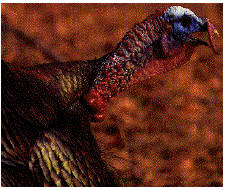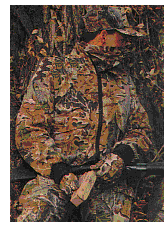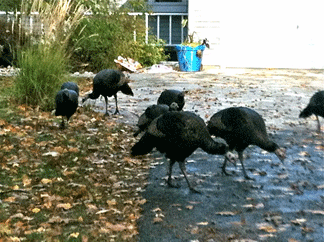A wild turkey is an exciting bird to hunt. For a long time, turkey experts said that wild turkeys could never survive a winter in the north. In spite of the experts, a few years ago Michigan introduced turkeys into Menominee County, and they are happily surviving and propogating to this day. Some of the turkeys flew across the River into Marinette County, Wisconsin. There they proceeded to thrive and multiply, moving north in their marvelous new climate. They came north to Crivitz,WI then to Iron Mountain, MI and then spread out into all the surrounding counties. Turkeys are hunted in the spring in contrast to other wild game birds which are hunted in the fall. In the spring, the tom looks different than the hen. Gobblers are legal game, but hens are protected. In spring the gobbler starts gobbling loudly and strutting around the hens at every chance they get. The colors of the tom become iridescent, seeming to change when he gets excited or turns in different directions. He displays like a peacock by fanning out his feathers until he looks much larger than he is. Gobblers also have a beard growing from their breast. In spring a pad of fat grows under this beard causing it to be exhibited more prominently. The gobbler needs this extra fat during the spring mating season since he rarely eats. Some hunters believe the hen selects her mate according to the size and shape of the beard.
The most effective way to hunt a gobbler is by imitating the sounds of other turkeys, especially a lonesome hen, so the gobbler will come looking. Turkey calls are sold commercially but perhaps the easiest for the novice to use is the box call. With this caller and a few hours practice, you have a chance to call in a gobbler. When you can use the box call, crawl into your camo and head for the woods. Finding the gobblers is at least half the battle.Turkeys, like other birds, are up at first light. You need to get into the woods before the turkey gets up. Toms roost in trees. They wake up thinking about the girls, and usually start gobbling from their roost. If you can't hear a gobbler going at it, use the turkey call. If there are gobblers nearby, most nearby toms will answer the call. After you locate a turkey gobbler, head for the sound as quickly as you can before the turkey comes down from the roost. Although you may not hear or see them, nearby hens are also heading towards the gobbler. Try to get there first. If you don't, the gobbler may come down to visit the girls. Don't shoot at the gobbler if it is near a hen. Hens are protected. You really don't want to look the game warden in the eye while trying to explain why you shot at protected bird. Keep calling and sooner or later you will be able to get within 75 yards or less of a gobbler. Hide yourself as well as you can and start calling. Turkeys have an amazing variety of calls and they all mean something different. The call that usually works best is the lonesome hen call. If you make it sound real, the gobbler will sound off immediately. How often you should call after the gobbler sounds interested is determined by how he acts. If he sounds loudly and quickly, call often, every two minutes or so.Otherwise only call every ten minutes or so. When you finally get a shot, aim carefully at his neck. This aim point covers his head and neck with the spread of your shotgun pellets. Most serious turkey hunters use a 12-16 gauge shotgun with #4 shot. Turkeys are so well covered with feathers that body shots usually result in cripples and lost birds or mangled meat. The turkey gobbler is a rare and marvelous trophy, comparable to a big buck. If you really think you're good, try hunting him with a bow and arrow. Apply for the Michigan or Wisconsin turkey hunt by contacting the nearest DNR Field Office for an application. Applications are available in the fall for the spring hunt. Since this page was written, turkeys have made a home in the Upper Peninsula and northern Wisconsin and are often seen strutting along the highway or even in backyards.
Turkeys in the Yard: J Martin |


